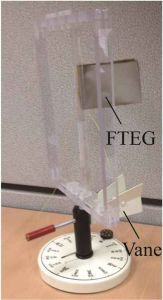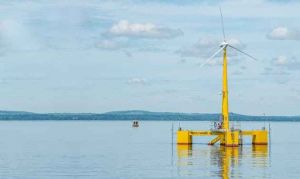“You got me flipping like a flag on a pole/Come on baby let the good times roll!”
The words of the song were brought to my mind when I came across some interesting research recently. When one thinks of wind energy one thinks of large towering majestic turbines spinning atop hills or in arrays beyond the coastline. But while they may be the most cost effective way to produce electricity from the wind now, it may not always be that way. A few days ago I was walking alongside a river in a mild breeze and there was a lot of flapping sounds coming from the flags on top of the sailing ships moored along the banks. Similarly have you ever witnessed the power of the wind fluttering groups of flags of many nations outside of buildings such as the United Nations, the European Commission headquarters and the like? other people have including scientists and researchers…
A study has just been published in the publication Nature Communications. It’s authors describe an experimental generator, which builds a charge using mechanics that are similar to what happens when you rub a balloon against your hair. When a breeze hits the small device, pictured below, the electrode-coated flag flips into motion, brushing against a conducting counter plate. This simple rubbing action builds up a static charge on the counter plate’s polymer surface, in what’s called a triboelectric effect. A small capacitor then captures the charge.
Unlike the large flags on top or outside buildings all the researchers flags were very small—less than 5 inches in length, and 4 in width—but they were varied in their dimensions. They were produced from a synthetic textile coated with gold, which as every schoolboy knows is a highly efficient conductor. Each counter plate sandwiched another piece of this gold-coated fabric between a stiff unmoving baseboard and a Teflon-like polymer called PTFE which is the heart of the triboelectric system. When the gold flag flaps against it, in a simulated breeze, it builds up a static charge, which the gold in the baseboard then conducts into the capacitor.
The research team built several of the devices to test different combinations of length and width configurations. In just a low breeze, longer, thinner flags were found to generate more charge because they contacted the counter plate more often. In stronger winds, the long flags became too manic and chaotic and their performance fell off and little or no charge was collected. However in strong winds the flags, despite acting chaotically, still made regular enough contact with the counter plate to hold a significant charge. The flags were quite durable: After over 12 million flutters, a test flag began to show signs of wear but showed only a tiny decrease in power output.
Is this the future of wind power? Unlikely. Each flag creates only a very small amount of electricity, and the authors of the paper suggest that building arrays of flag generators would be necessary to generate substantial amounts of power. The researchers also took the generators outside for field tests. They attached a flag generator into a weather vane. Flapping in a 8-11 mph light breeze generated only a tiny charge: It would take thousands of them to power an energy efficient 10 watt LED. The researchers managed to generate substantially more energy by mounting a flag on top of a car cruising along at 45 mph, but still not enough to make the power generated offset the fuel used.
It seems that for the forseable future, wind power generation will be left to wind turbines!
The article details are set out below:
Title: Flutter-driven triboelectrification for harvesting wind energy
Authors:





